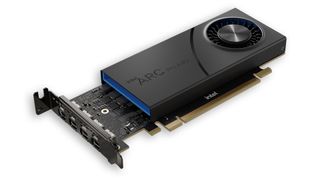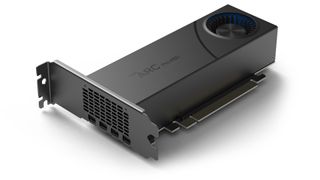Intel Unveils Arc Pro GPUs
Intel graphics: not just for gamers

Intel’s Arc graphics cards aren’t just for gamers, it seems, as the previously CPU-exclusive company has taken the lid off a new line of professional GPUs to complement the existing Arc line — well, existing in China, maybe. The new cards are called Arc Pro, and target those who use their graphics cards for more than shooting bad guys. Maybe they won't be among the best graphics cards for gaming, but the AV1 encoding at least might get some takers.
Intel today unveiled one mobile professional GPU, the A30M, and two desktop models: the single-slot A40 and double-slot A50. Both desktop cards are described as being for small form-factor machines, which makes us suspect Intel may have some much larger cards up its sleeve.

All the newly announced GPUs feature built-in ray tracing hardware, machine learning capabilities and industry-first AV1 hardware encoding acceleration. Google’s royalty-free, open source alternative to HEVC, AV1 hasn’t gained a lot of traction on the web so far despite promises from Netflix and YouTube, with its main use being in Google’s Duo video calling despite beating HEVC for compression quality. It’s always been very slow to encode, however, so a good hardware accelerator and Intel’s backing could see it take off.
Elsewhere, the Intel Arc Pro A-series graphics processors are certified ready with leading professional software applications within the architecture, engineering and construction, and design and manufacturing industries. And you can also use them to run the likes of Blender and the open source libraries in the Intel oneAPI Rendering Toolkit, which “are widely adopted and integrated in industry-leading rendering tools,” according to Intel.
We do have to wonder about the drivers situation with Arc Pro. There have been numerous documented problems with the Arc A380 cards, and Intel has already released several driver updates — which can ultimately get Windows into a state where the drivers won't even install, according to Gamers' Nexus. Other aspects of the drivers, like Smooth Sync, are broken. But perhaps that's because Intel has been focusing its driver efforts on the professional side of things? We hope that's the case, because as bad as the consumer drivers are, professionals will be far less willing to deal with broken support.
SIGGRAPH attendees in Vancouver this year will be able to see Arc Pro demos at Intel’s booth, while the rest of us can wait for the chips to be released “later this year.” We look forward to pitting the Intel Arc Pro cards against Radeon Pro and RTX A-series offerings from AMD and Nvidia.
Stay on the Cutting Edge
Join the experts who read Tom's Hardware for the inside track on enthusiast PC tech news — and have for over 25 years. We'll send breaking news and in-depth reviews of CPUs, GPUs, AI, maker hardware and more straight to your inbox.

Ian Evenden is a UK-based news writer for Tom’s Hardware US. He’ll write about anything, but stories about Raspberry Pi and DIY robots seem to find their way to him.
-
cyrusfox A30M, A40 Desktop and A50 double slot desktop...Reply
Are they all based on the smaller die Arc ACM-G11 or do any of them boast the full die Arc ACM-G10 (Image link of basic spec of both dies). Would think the pro line would boast larger VRAM as well as price. I might rather pick one up a pro line over the A310/A380 for one of my machines. But like always subject to availablility, price and if there are really any feature differences. -
ingtar33 nothing spells "professional" graphics card like unstable drivers which crash constantly doing basic things. How about intel iron out their horrific driver issues with their gaming cards before selling "professional" graphic cards who will be about as useful as expensive paperweights thanks to the driver issues they're likely to have.Reply -
Lorien Silmaril they "unveiled" professional cards when their consumer cards can't even launch. looks DOA to me.Reply -
TerryLaze Reply
Do they share the same driver? Gaming is based on tsmc chips while professional is mostly intel chips except for I/O.ingtar33 said:nothing spells "professional" graphics card like unstable drivers which crash constantly doing basic things. How about intel iron out their horrific driver issues with their gaming cards before selling "professional" graphic cards who will be about as useful as expensive paperweights thanks to the driver issues they're likely to have.
Most Popular

